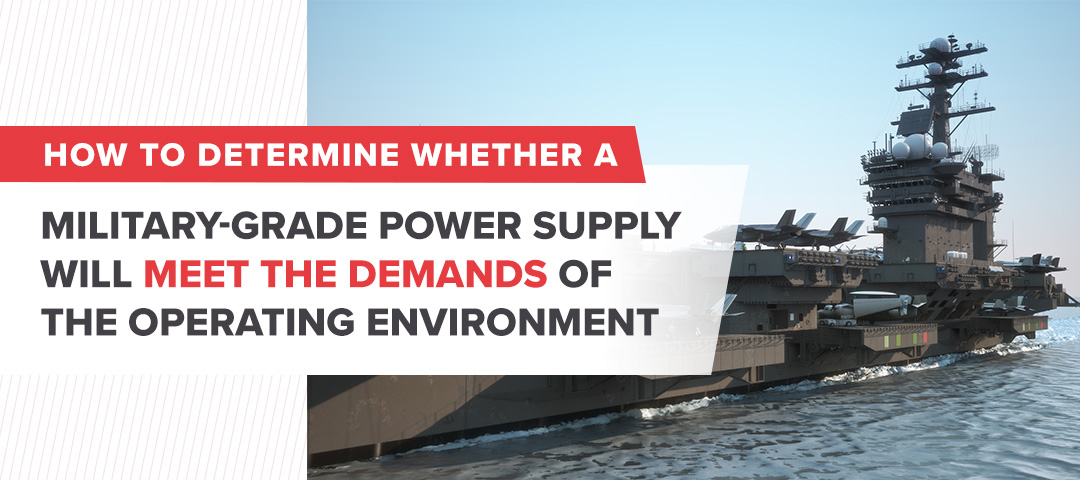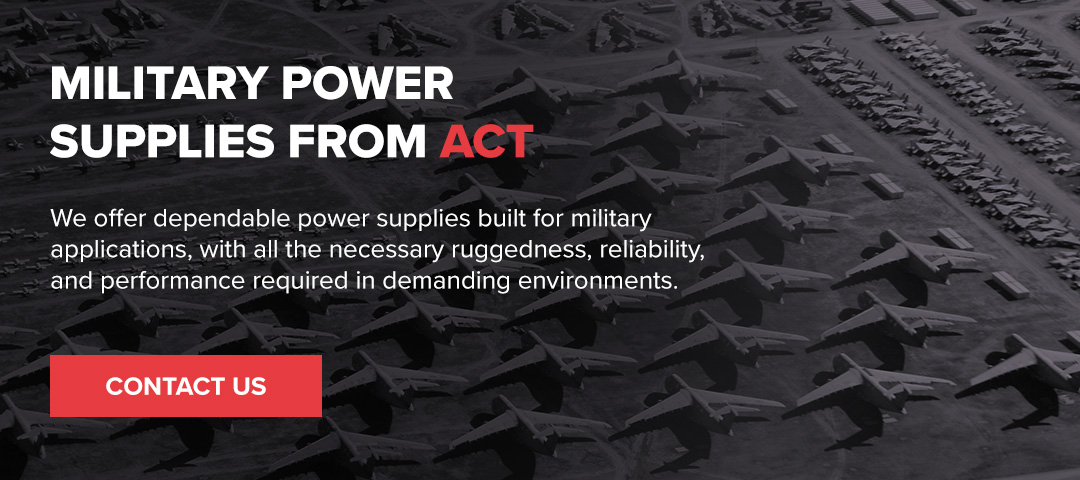
Not all power supplies are created equal, especially when the military is involved. Military power supplies are specially designed to meet the industry’s needs, offering rugged protection against harsh environments and adherence to strict quality standards. Certain environments call for specific power supply features. You’ll need to evaluate many different power supply factors to determine whether it is right for a specific military environment.
The Need for Military Power Supplies
Military operations occur in demanding environments, and working power supplies are mission-critical. If vital equipment fails, the results could be catastrophic. This need for high-end power supplies has made the defense sector a large part of the rugged power supply industry’s steady growth. The military needs to keep equipment running at all costs and ensure superior reliability.
Most of their counterparts, commercial off-the-shelf (COTS) solutions, are generally unsuitable for use in demanding environments like aircraft, sea craft, or military transport equipment because of their short mean time between failure (MTBF). They tend to experience interruptions more often, and military applications require a much longer MTBF. A longer MTBF allows them to offer more dependable, reliable performance in critical operating conditions.
Other differentiators between military power supplies and commercial power supplies include ruggedized housings, special sealing mechanisms, advanced diagnostic technology, and high efficiency. They have more safeguards in place to ensure predictable, steady operation, whether they’re being used in the heat of the desert, the arctic, under the ocean, or in space. Military-grade power supplies are necessary for both tough and more demanding environments due to their improved reliability and performance.
Environmental Challenges the Military Faces
Environmental threats are some of the most pressing issues facing military power supplies. They need to maintain performance in the presence of hazards that could incapacitate other power supplies. Power supplies for the military face environmental threats including moisture, radiation, temperature, shock, and vibrations.
Moisture
Humidity, rain, snow, ice, condensation, and many other forms of moisture can cause problems for normal power supplies. Military power supplies are designed to withstand water ingress and damage without adding undue weight or size to the unit. This high sealing integrity may require more advanced techniques. For example, one method to address atmospheric condensation is to fill the power supply’s casing with a nonconductive thermoplastic material before sealing it.
Radiation
Military power supplies also outpace their COTS counterparts when operating in the presence of radiation, such as in environments with high levels of solar radiation or electromagnetic interference (EMI). The device could even be a significant emitter of EMI itself. Military power supplies reduce noise and perform well in the presence of radiated or conducted emissions.
Temperature
While many commercial power supplies are designed for use in moderate temperatures, military power supplies can operate well in a much wider temperature range and with more extreme changes. Military power supplies work in extremely low- and high-temperature environments, making them suitable for settings as drastic as under the ocean, in space, or baking under a desert sun. They can generally withstand temperatures as high as 80°C and as low as -40°C.
Military power supplies also accommodate vast and sudden temperature changes. For other power supplies, a quick change in heat could cause thermal shock, damaging or shutting down the system, but military power supplies can stand up to this change. This capability is vital for many applications, such as transportation equipment, which might be stored in an air-conditioned location but quickly deployed into a hot environment.
Shock and Vibration
Lastly, military power supplies stand up to high levels of shock and vibration, a necessity in many military environments. Consider platforms like ships, aircraft and spacecraft, where power supplies are exposed to acceleration, ongoing vibration, and sudden mechanical shock.
Military power supplies undergo robust vibration testing according to their applications. There are five main vibration levels power supplies can fall under, including space vehicle, naval shipboard, ground mobile, fixed-wing, and rotary-wing. Military operations can also undergo sudden impact, so power supplies must withstand mechanical shock.
Choosing a Military Power Supply That Suits Its Environment
While power supplies for military use are generally rugged and reliable, several different factors will influence which one is right for your needs.
Environment and Application
You’ll first need to understand your environment and application. Different settings require different features and protective mechanisms. If the power supply will be used in a humid environment, look for powerful seals and adherence to Ingress Protection (IP) codes such as IP-67 for dust-tight and water-tight to 1 meter. You’ll also want to ensure it is tested to MIL-STD-810, 512.5 Immersion.
Standards and Testing
To ensure a power supply meets your needs, look for adherence to military standards, including:
- MIL-STD-810: This standard covers environmental design and ensures the power supply can withstand many of the hazards discussed. It includes high altitudes, low-pressure situations, sudden temperature shifts, prolonged exposure to high and low temperatures, rain and humidity, sand and dust, and random vibrations.
- MIL-STD-461: The EMI standard tests the power supply in a specially shielded chamber to prove that it can operate properly in the presence of EMI and radio frequency interference.
- MIL-S-901: MIL-S-901 applies to high-impact shock. Power supplies are categorized by their grade, class, and type. They are also tested according to their necessity for safe operation aboard a ship, whether they are principle, subsidiary or subassembly components, and where and how they are mounted.

Other military specifications for power supplies include MIL-STD-704 for aircraft, MIL-STD-1275 for ground vehicles, and MIL-STD-1399 for shipboard. The standards address input power requirements and cover topics such as voltage, maximum current, electrical noise, and abnormal conditions for AC and DC systems.
Most of the time, military testing must be conducted by a certified laboratory. At Advanced Conversion Technology, we do our quality testing in-house based on a quality management system certified to AS9100D and ISO 9001:2015. We also abide by a variety of other robust specifications for workmanship and supplier policies.
Efficiency
The efficiency of military-grade power supplies can play a significant role in reliable operation in harsh, temperate environments. Selecting the proper topology for a switch-mode power supply not only takes into account the performance requirements, but also the environmental conditions in which the power supply will operate. The efficiency of the power supply is a key component of the thermal management of the unit. When efficiency is improved, less heat dissipates from the switching elements, thus improving the reliability of the power supply’s operation in a temperate environment. Topologies that employ Zero Voltage Switching, Zero Current Switching, Synchronous Rectification, and Phase Shifted Full Bridge switching are employed to not only improve efficiency but also to allow for a power supply design that can be contained in a smaller chassis.
Ruggedness and Reliability
Ruggedness is par for the course in military power supplies. It helps ensure reliable performance with heavy-duty components built for nearly any environment. Many power supply components can be ruggedized, including transformers, converters, inverters, EMI filters, and over-voltage protectors. Circuit boards are encased in metal with EMI shielding to help them withstand tough conditions. Another option is to use gold plating, which can prevent corrosion in damp settings and optimize circuit grounding.
Military power supplies must also provide reliability through self-diagnosis. They might report operating conditions like over- and under-voltage, temperature, and over- and under-current. They could also provide N+1 redundancy, which sends a message when a backup system is activated because the primary unit has failed. It allows a technician to respond quickly and troubleshoot devices before total equipment failure.
Military Power Supplies From ACT
Advanced Conversion Technology has been delivering custom solutions to the defense industry for decades. We offer dependable power supplies built for military applications, with all the necessary ruggedness, reliability, and performance required in demanding environments. With over 40 years of engineering expertise and compliance with some of the industry’s strictest standards, we’re the trusted source for custom military power supplies.
To learn more about our extensive work with power supplies for military operations, reach out to an expert today.
